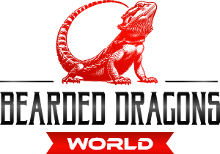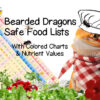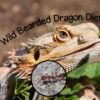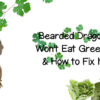Bearded dragon teeth possess a unique dental constitution that reflects their omnivorous diet. These lizards have teeth that are adapted for gripping and slicing through a variety of food items, from insects to vegetables.
Unlike mammals, bearded dragons have 2 types of teeth, some of which continuously renew throughout their lifetime.
The dental structure of bearded dragons consists of both polyphyodont (poly·phy·odont) and monophyodont (mono·phy·odont) teeth. Polyphyodont teeth have the capacity to be replaced numerous times, while monophyodont teeth do not regenerate.
This combination provides an excellent model for understanding the mechanisms behind tooth development and renewal in vertebrates. The tissue differentiation and the genetic aspects of tooth replacement in bearded dragons have provided insights into potential pathways that regulate tooth development in other species as well.
In captivity, dental health is a significant aspect of bearded dragon care. Bearded dragon teeth are vulnerable to dental disease which severely impact their overall well-being.
Captive bearded dragons require environmental enrichment and a proper diet to maintain their dental health. Studies into the prevalence and risk factors for dental disease in captive bearded dragons contribute to better management practices to prevent such conditions (Mott, Pellett & Hedley, 2022). These practices help ensure that the bearded dragons maintain robust teeth, which are integral to their survival and quality of life.
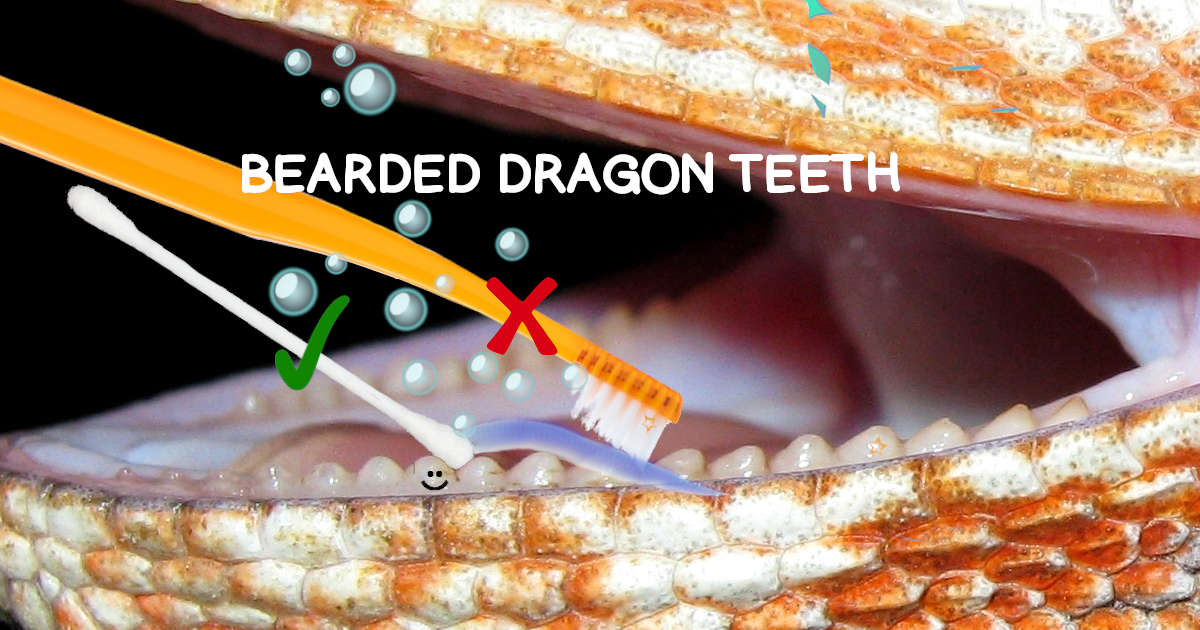
Jump To…
Anatomy of Bearded Dragon Teeth
The dental structure of bearded dragons is quite specialized, reflecting their unique feeding habits and lifestyle in the wild.
Bearded dragon teeth are unique because they have different kinds of teeth in their mouth. Some teeth at the back don’t grow back when they fall out (they are called monophyodont), while the ones at the front can keep growing back (polyphyodont). These teeth can look quite different, and they can change in number and shape as the lizards grow (Cooper et al., 1970, and from what we’ve seen ourselves).
This bearded dragon is one of the few animals with such different teeth in one mouth. That makes it perfect for us to learn about teeth and how they grow. Unlike most other animals with replaceable teeth, these dragons take their time growing new ones, and they have a special part in their mouth that helps with this.
In adult bearded dragons, their front teeth take on a canine-like shape, similar to those of meat-eating mammals. Interestingly, these canine-like teeth are absent in hatchlings and only develop as the bearded dragons grow up. These teeth attach slightly to the side of the jawbone, not on top as in some other reptiles.
In adults, the front teeth fit together like pieces of a puzzle when their mouths are closed. The first lower jaw tooth fits neatly between the middle and side upper jaw teeth. This pattern continues with the other teeth, although it may sometimes look a bit irregular.
Bearded dragons possess acrodont teeth, where the teeth are fused to the jawbone’s summit rather than set in sockets. This type of dentition is robust and suitable for their diet, which mostly comprises insects and plants. Bearded dragons typically have a relatively uniform and simple tooth shape (LafeberVet, 2018), which differs from the more varied dentition found in mammals.
Their acrodont dentition lacks the capacity to undergo significant repair, making tooth decay (LafeberVet, 2018) a serious issue for captive bearded dragons who are not provided with a natural diet. In terms of function, bearded dragons utilize their teeth primarily for seizing and holding prey, rather than the complex mastication seen in humans.
As bearded dragons mature, their small teeth are replaced by larger ones. In some cases, you might notice more teeth than usual, causing a temporary change in their ‘bite’ from the usual arrangement.
Unlike pleurodont teeth, acrodont teeth erupt towards the posterior of the jaw and are never shed. The eruption of pleurodont teeth pushes out the anterior acrodont teeth, but the overall count of acrodont teeth remains constant once the animal reaches maturity.
The degree of wear on acrodont teeth varies depending on the lizard’s age and the specific tooth’s position. The frontmost acrodont teeth are typically the first to experience abrasion due to contact with their counterparts.
Subadults usually exhibit little to no wear in the posterior quarter of the tooth row, while older individuals may experience complete obliteration of both acrodont and pleurodont tooth rows, resulting in a toothless ridge along the jaw.
Baby Bearded Dragon Teeth
In all bearded dragon species (Pogona), their teeth follow a consistent pattern. When they’re born, they have a single ‘egg tooth’ in the middle. The egg tooth in the middle of the upper jaw starts as an egg tooth and then changes into a regular pleurodont tooth.
Soon, small teeth appear on each side of the front of their upper jaw, and later, a central tooth grows in. (Witten, 1994)
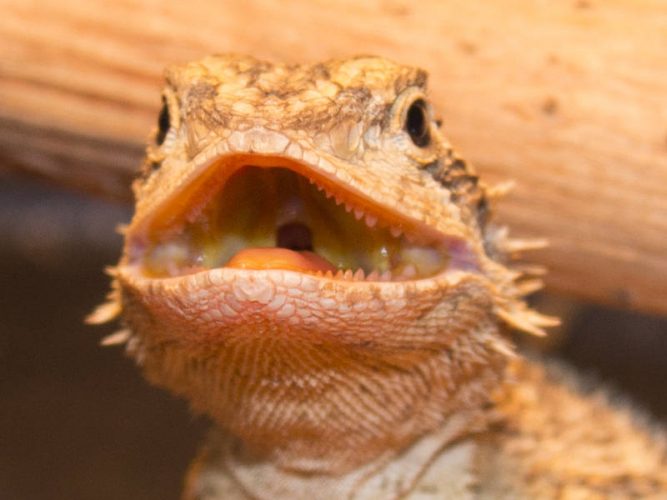
Tooth Growth and Development
Unlike humans who have diphyodont dentition, with two successive sets of teeth, bearded dragons are polyphyodonts, meaning they can regrow (Salomies, Eymann, Khan, Di-Poi, 2019) teeth multiple times throughout their lives. The renewal process, known as polyphyodonty, allows for the replacement of teeth that may be damaged or lost.
Juvenile bearded dragons exhibit a more active replacement cycle, which is crucial as they grow and their dietary needs evolve.
Do Bearded Dragons Grow New Teeth?
Bearded dragon teeth have unique dental characteristic among reptiles. They have both polyphyodont (poly·phy·odont) and monophyodont (mono·phy·odont) teeth. Polyphyodont teeth are those that are continuously replaced throughout the animal’s life, while monophyodont teeth do not get replaced once lost.
In bearded dragons, this means that while some of their teeth can regrow if lost, particularly the pleurodont teeth, their monophyodont teeth, once lost, do not regrow.
This dual dental system is quite rare in the animal kingdom and makes their dental care a bit more complex. It’s important to note that the regenerative capacity of their teeth may not be as robust as in some other reptiles, emphasizing the need for careful dental maintenance.
Therefore, while some of the bearded dragon teeth do have the ability to regrow, the acrodont teeth do not regenerate once lost. This underscores the importance of maintaining good dental health for these pets, as losing these teeth can affect their ability to eat and overall health.
To keep bearded dragon teeth in good condition they require:
- Regular dental check-ups
- A balanced diet, and
- Proper husbandry practices.
Oral Health and Diseases
Bearded dragon teeth require good oral health practices to prevent health issues. Understanding common dental diseases and recognizing the signs of oral complications are vital steps in prevention and early intervention.
What sets acrodont teeth apart is that the gum tissue doesn’t attach at the base of the teeth. Instead, there’s a thin layer of squamous epithelium that covers the exposed jawbone, making it susceptible to bacterial colonization (Thomas, 2020).
The prevalence of periodontal disease is not well known. Karingal Veterinary Hospital in Victoria, Australia assessed 62 bearded dragons (Pogona vitticeps) over 6 months and found that 35% had periodontal disease (Simpson 2015). That is 1 in every 3 bearded dragon’s with periodontal disease. How representative this is of pet bearded dragon’s is yet to be understood.
Bearded Dragons Get Dental Disease or Periodontal Disease: A Technicality
In research by Mott, Pellett & Hedley (2020) they discussed the use of the phrase “periodontal disease”. Periodontal disease is frequently used to cover all phases of dental problems in reptiles with acrodont teeth. However, these creatures do not possess a periodontal ligament. As a result, the Mott, et al (2020) propose using the term “dental disease” instead of “periodontal disease” when referring to animals with acrodont teeth. Both periodontal and dental disease is interchangeable in this post.
Grading Bearded Dragon Dental Disease
The Centre for Bird and Exotic Animal Medicine posted Dr Dayna Willems infographic on the stages of bearded dragon dental disease with pictures (see below).
Biggest Contributing Factors To Dental Problems In Bearded Dragons
Mott et al (2020) investigated factors that contribute to dental problems in one of the most common pet reptiles, the central bearded dragon (Pogona vitticeps). Data collected from 20 veterinary clinics in the United Kingdom (304 central bearded dragons) showed that 24.8% with dental disease showed visible signs of trouble. These signs were indicative of advanced dental disease.
The researchers graded the bearded dragon teeth according to dental disease as:
- grade 0, showing no dental issues,
- grade 1, with staining and exposed bone;
- grade 2, featuring mild tartar and gingival issues;
- grade 3, showing moderate tartar and more severe gingival problems;
- grade 4, having severe tartar buildup, extensive gingival issues, jawbone inflammation;
- grade 5, representing end-stage disease with severe tartar, extensive gingival recession, jaw inflammation, and pathologic fractures.
They found that the percentage of central bearded dragons with dental problems increased with age, rising from 11.5% in those younger than 1 year to 36.9% in the 1 to 3-year age group and significantly higher, at 86.8%, in those older than 8 years. Dental disease was also linked to being under or overweight and having concurrent health issues.
Additionally, there was a strong association between including fruits in the bearded dragons’ diet and dental problems, with a significant odds ratio of 2.68.
Approximately 66% of central bearded dragons that consumed fruits experienced dental disease. On the contrary, there was no significant link between including vegetables in their diet and dental issues. As a result, the authors suggested removing fruits from the dragons’ diet because the high sugar content and acidity in fruits may contribute to dental disease.
Wild Bearded Dragons Do Not Show Signs of Dental Disease
Dental disease in bearded dragons is not something seen in the wild bearded dragon, it is associated with husbandry practices in captivity (Reusch, 2009; Hedley, 2016).
In support of this, preserved bearded dragons from the National Museum of Victoria collection were assessed for signs of dental disease. None were found to have signs of any issues including being free of calculus deposits, gingival recession or swellings (McCracken and Birch, 1994).
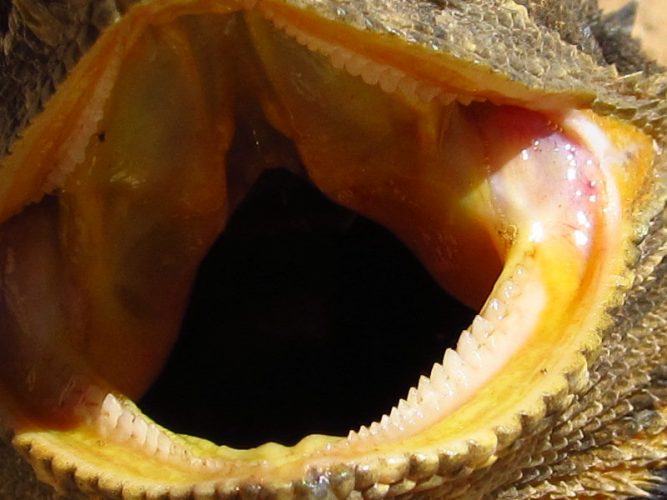
Matt from Melbourne, Australia / CC BY
Common Dental Diseases
Bearded dragon teeth can suffer from a variety of dental diseases, such as gingivitis, mouth rot (stomatitis), and dental disease.
- Gingivitis is characterized by inflammation of the gums, often a precursor to more severe conditions. The acrodont teeth are attached to the jaw, and the gum is thin. This makes them vulnerable to being exposed if the gum is damaged such as with gingivitis. Gum recession from gingivitis is permanent.
- Dental disease, a widespread problem in these reptiles, is linked to soft diets and can result in tooth loss. It’s also reported that dental abnormalities are prevalent in captive bearded dragons and there is a significant need to investigate the factors influencing disease severity.
- Mouth rot, or infectious stomatitis, can manifest when bacteria proliferate in the mouth, leading to severe infection and inflammation. This condition may cause black or brown teeth, indicating tooth decay, which, if left untreated, can develop into systemic health issues.
Signs of Oral Diseases
Signs of oral diseases include:
- Visible black on teeth, brown teeth,
- Receding or inflamed gums, and lost teeth.
- An accumulation of tartar or unusual redness may signal gingivitis or early stages of dental disease.
- Bearded dragons with oral health issues might also exhibit a lack of appetite, difficulty eating, or swelling around the jaws.
Other signs of bearded dragon dental disease include:
- Anorexia
- Lethargy
- Pain on mastication
- Trouble in swallowing food
- Loss of appetite
- Swelling around the mouth
- Bleeding in the mouth
- Sore on his mouth
- Red gums (gingivitis)
- Receded gums
- Lost teeth, loose teeth, missing teeth
- Changed colour of the teeth and/or the bone. Brown teeth, black teeth, green teeth, yellow teeth.
- Increased mucus in the mouth
These symptoms require medical attention.
Tooth loss in bearded dragons is particularly concerning, as their acrodont dentition means their teeth are fused to the jawbone and cannot be replaced if lost. Consequently, preventing dental problems through proper diet and habitat maintenance is essential to avoid irreversible conditions like having no teeth.
Regular monitoring of a bearded dragon’s oral health can prevent the onset of these dental conditions, facilitating a better quality of life. Therefore, being informed about the prevalence and risk factors for dental disease in captive central bearded dragons is fundamental to responsible reptile care (Mott, Pellett & Hedley, 2020).
7 Things That Can Rot Your Bearded Dragons Teeth
- A lot of soft food and sugar rich foods (Reusch 2009; Mayer 2013; Simpson 2015) :
- Soft bodied insects,
- Soft or softened foods (such as when shredded or cooked),
- Soft plus sugar rich fruit.
- Nutrition – too much or too little calcium powder, and micronutrient deficiencies (Simpson 2015).
- Stress (Simpson 2015):
- Stress may not be noticable. Signs that are noticable include banging its head or glass surfing, this can cause damage to rostral area.
- Compromised immune system.
- Nutritional Secondary Hyperparathyroidism (MDB).
- Fighting.
- Large struggling food such as live vertebrate being fed.
The video above posted by Harvest Pointe Animal Hospital in Canada, Alberta. The vidoe shows can happen if bearded dragon dental disease is not addressed. “The dental disease had disintegrated the Maxillofacial Bone so much that it was wiggling and had to removed.”
Diet and Nutritional Impact on Dental Health
A bearded dragon’s dental health is closely linked to its diet. A bearded dragons teeth are designed for their natural diet. In captivity a balanced intake of calcium, vitamins, and appropriate foods is vital to prevent dental diseases and ensure proper tooth structure and jaw health.
Proper Diet for Healthy Teeth
It doesn’t take black teeth and gums to show for dental disease to be present. At first the disease will show as a light brown color, perhaps spotted around the teeth.
For optimal dental health, bearded dragon teeth require a diverse diet that includes leafy greens, vegetables, and adequate protein sources. Crucial components of a healthy diet are calcium-rich foods and vitamin supplements, particularly vitamin D3, which facilitate proper calcium metabolism.
Offering a variety of greens and vegetables, such as collard greens, bell peppers, and squash, provides essential nutrients and helps maintain strong teeth.
Bearded dragons also benefit from a controlled amount of protein. Feeder insects should be dusted with calcium powder to counteract the potential for metabolic bone disease and ensure proper oral development.
Bearded dragon teeth are not designed for a lot of soft foods. Soft foods in their diet should be measured, as overly soft or sugary foods can lead to plaque accumulation and potential dental issues.
Soft Foods In The Diet Harm Bearded Dragon Teeth
Dental disease is associated with diet. Soft diets are not good for bearded dragons teeth (Reusch 2009; Mayer 2013).
McCracken and Birch (1994) examined nine bearded dragons (Pogona vitticeps and Pogona barbata) in 1989 at the Melbourne Zoo. They all appeared to be normal, except for one that had an abscess in the mouth. However, on examination all were found to have dental disease.
The bearded dragons with dental disease had been fed soft diets consisting mainly of fruit when taken to classrooms. Diets of the zoo’s bearded dragons from there on were changed to firm foods including 7-10mm cubed pieces of vegetables.
These researchers described a similar event at the Zoo with Pogona minor in 1990. Fed on soft diets severe dental disease eventuated within a year. Their diet was changed to only insects which was considered closer to their normal diet and no further issues were seen.
Feed rougher and harder foods along with the soft foods. Soft foods include mealworms, superworms, many fruits and so on. Hard foods can become soft by grating, shredding and cooking. Grating and shredding foods requires less mastication, results in less abrasion on the teeth to keep them clean (Simpson, 2015) and can contribute to disease.
Particles of soft foods are easily trapped within the mouth which promotes bacteria and plaque build up. Soft foods do not offer abrasive surfaces useful for cleaning teeth. Harder or rougher foods don’t present the same level of issue and they help toughen the mouth tissue.
Easy changes in diet that can be made include switching from feeding mealworms as larvae to their adult stage as beetles. Consider adding the occasional snail, phasmid and other beetles. For more on feeding see the post on diet and feeding.
Effects of Nutrient Deficiency on Teeth
Nutritional deficiencies can have a detrimental impact on a bearded dragon’s dental health. Insufficient calcium intake often results in nutritional secondary hyperparathyroidism, a condition where the body starts to consume calcium from the bones and teeth, leading to weakened jawbones and tooth loss. This deficiency can also cause malformed teeth and affect the stability of teeth within the jaw.
A lack of vitamin D3 hampers a bearded dragon’s ability to absorb and utilize dietary calcium, further exacerbating dental and skeletal problems. If fed on an improper diet lacking in crucial vitamins and nutrients, bearded dragon teeth are prone to develop these health issues.
Preventing Dental Problems in Bearded Dragon Teeth
Proper dental care for bearded dragons encompasses daily oral hygiene practices to reduce plaque buildup and veterinary care for regular examinations. Implementing a consistent routine significantly decreases the chance of dental diseases.
Can I Clean My Bearded Dragon Teeth?
Cleaning bearded dragon teeth regularly may support good oral hygiene. Toothbrushes may be difficult and too big. A better solution is a cotton swab.
Do not use human toothpaste, as it can be harmful to them. Consult your vet for appropriate solutions.
Cleaning teeth can help prevent disease and add to the long term quality of life.
How Often Should I Clean My Bearded Dragons Teeth?
Incorporating a bearded dragon teeth cleaning routine helps prevent the accumulation of plaque, which if left unchecked can lead to serious oral health issues.
Do you need to clean your bearded dragons teeth? Yes you should clean bearded dragon teeth. Here is what 3 vets around the world have to say about how often you should clean bearded dragon teeth:
- DVM Shane Simpson (2015) recommends cleaning a couple of times a week to slow down bacterial action.
- Brisbane Bird and Exotics Veterinary Services (2016) recommends removing plaque every 2nd day before it hardens into tartar. Use a cotton bud and diluted chlorhexidine solution as per veterinary guidelines for oral care.
- DVM Dayna Willems recommends cleaning bearded dragon teeth with chlorhexidine solution or diluted povidone-iodine solution 1-2 times a week for mild discoloration and every 1-2 days when teeth are discolored, brown or black with mild yellow tartar buildup.
What Can I Clean Bearded Dragon Teeth With?
Chlorhexidine is an antiseptic and disinfectant effective against yeast, viruses, fungus and bacteria. Considered non toxic it is used in concentrated form to clean surfaces and less concentrated it is used to treat wounds, skin conditions, gingivitis, dental disease and other applications.
Chlorhexidine is only used at full strength for cleaning. Discuss with your vet the concentration suitable for cleaning your bearded dragons teeth. Getting the concentration right is important to ensure effectiveness and safety. Concentration could be as little as 0.05 or 0.2%.
In humans, it is recommended that chlorhexidine mouthwash is used for no longer than 4 weeks and doing so can lead to staining of teeth and a buildup of tartar (James et al, 2017). Speak to your vet for advice.
Preventative products that may be used include Maxi/guard (made for animals) and Oral Gel (made for humans) (Simpson, 2015).
Both Maxi/guard and Oral Gel are easy to apply. Maxi/guard application instructions are to place a droplet on either side of the mouth on the teeth.
Consult your vet before using any products. Remember to arrange for your bearded dragon to have its teeth cleaned during your annual vet visit which should be done prior to winter in preparation for brumation each year.
Removing calculus and staining on the teeth requires a vet. The vet will anaesthetise the bearded dragon and manually clean the teeth.
How To Clean Bearded Dragon Teeth
Bearded dragon’s teeth are best cleaned with a Q-tip. Here are some steps you can follow:
Materials:
- Chlorhexidine solution or diluted povidone-iodine solution.
- Q-Tips (aka Cotton Tips)
- Secure Your Bearded Dragon:
- Gently hold your bearded dragon with one hand, ensuring that it’s comfortable and not stressed.
- You may want to wrap your bearded dragon in a small, clean towel or cloth to help keep it calm and still during the process.
- Dip the Q-tip in Water:
- Dip one end of the Q-tip into the lukewarm water, making sure it’s damp but not soaking wet.
- Gently Wipe the Teeth:
- Very carefully and gently, use the damp end of the Q-tip to wipe the teeth of your bearded dragon.
- You can use a slight rolling motion to clean the teeth, moving from one side to the other.
- Pay special attention to the gum line and any areas where food or debris might be stuck.
- Rinse and Repeat (if necessary):
- You can dip the Q-tip back in water and continue cleaning if needed.
- Avoid using force or applying too much pressure to prevent any injury.
- Give Your Bearded Dragon a Rinse:
- After cleaning, use the dry end of the Q-tip or a different clean Q-tip dipped in water to gently rinse the mouth of your bearded dragon.
- Reward Your Bearded Dragon:
- Once you’ve finished cleaning, offer your bearded dragon a small treat or some fresh water to help make the experience positive.
It’s essential to be extremely gentle and patient during this process. If you notice any signs of distress or if your bearded dragon resists, it’s best to consult with a veterinarian who specializes in reptile care for a professional dental examination and cleaning. Additionally, maintaining a proper diet and providing clean water for your bearded dragon can help prevent dental issues in the first place.
The Center for Bird and Exotic Animal Medicine cleaned the teeth of Petrie the bearded dragon from the Reptile Zoo. In these videos the vet demonstrates how to clean bearded dragon teeth.
Want to beat that dragon breath? 🐉🐲🦷Watch ***part 1*** of 2
Posted by The Center for Bird and Exotic Animal Medicine on Monday, November 18, 2019
Want to beat that dragon breath? 🐉🐲🦷Watch ***part 2*** of our 2
Posted by The Center for Bird and Exotic Animal Medicine on Monday, November 18, 2019
Dental Scale and Clean
Bearded dragon teeth will benefit from a dental scale and clean at the vets, much the same as we humans do at the dentist. During these veterinary visits the vet will also check for preventing dental problems. Examine the dragon’s teeth and mouth for signs of dental disease before it has become a problem will be much less distressing and traumatic for pet and owner.
Cleanings performed by a vet can remove any buildup of plaque that daily brushing cannot address. In addition, the vet can recommend changes to the dragon’s diet to ensure it remains low in sugar—even from sources like fruit—to help keep bearded dragon teeth clean. Providing the right diet and professional care creates a comprehensive approach to maintaining dental hygiene.
Environmental and Husbandry Factors
Proper husbandry practices are crucial for maintaining the health of bearded dragon teeth. These practices impact both the physical environment and the level of stress that the reptile will experience.
Housing and Stress Factors
Housing conditions for bearded dragons must reflect their natural habitat to minimize stress. Stress can negatively impact their overall health, including their teeth. Key elements to focus on include:
- Space: Provide ample space to prevent overcrowding and stress-related behaviors which can lead to dental damage.
- Temperature: Maintain a thermal gradient to mimic natural conditions and promote proper digestion, which indirectly benefits dental health.
- UVB Lighting: Appropriate UVB lighting is essential for calcium metabolism, crucial for maintaining strong dental structure.
Ensuring a stress-free environment with proper husbandry practices can reduce the risk of behavior that causes damage to the acrodont teeth, such as glass surfing or excessive rubbing on enclosure furnishings.
Environmental Enrichment for Dental Health
To foster dental health through environmental enrichment:
- Textures and Surfaces: Incorporate a variety of textures and surfaces for the dragon to interact with, encouraging natural behaviors that can help manage tooth growth and health.
- Chewable Items: Provide safe chewable items to help bearded dragons wear down their teeth naturally to prevent overgrowth.
Consistent access to clean water and a balanced diet with proper nutrients also contribute to maintaining optimal dental health. An environment rich in enrichment reduces boredom and stress, promoting healthier behaviors that support dental wellbeing.
Bearded dragon teeth can be damaged through behavioral issues such as banging its nose into walls, wire and glass. If your bearded dragon is glass surfing or banging its head, the environment isn’t working for it. Try different housing and natural accessories.
Prevent falls. Never put your bearded dragon on high shelves, smooth tabletops or other things it cannot grip on and could fall.
Behavioral Aspects and Dental Health
Bearded dragons exhibit certain behaviors that can significantly affect their dental health, with biting and chewing actively influencing tooth wear, while social interactions can lead to trauma affecting the teeth.
Biting and Chewing Behavior
When bearded dragons feed, their biting and chewing actions are essential for food processing. They possess acrodont teeth, which are fused to the jawbone, limiting their capacity for tooth renewal. As a result, habitual chewing can cause gradual tooth wear. This is a normal part of their physiology and, under optimal conditions, should not lead to health issues.
Impact of Fighting and Trauma on Teeth
Aggression and fighting among bearded dragons, particularly in crowded or stressful environments, can lead to tooth damage such as fractures or tooth displacement. Such trauma is not uncommon and evidences the aggressive nature that these reptiles can exhibit. While they may display submissive behaviors such as flattening of the body to avoid conflict, serious encounters can result in significant dental injuries. Instances of trauma often necessitate veterinary intervention to prevent further health complications.
Bearded Dragon Has Lost Teeth
Your bearded dragon teeth may not have lost, instead they may be worn down. Bearded dragons do not naturally lose teeth but will naturally wear down. However, teeth can be lost if not cared for appropriately.

Bearded dragon teeth will wear down as they get older. Old bearded dragons may have no teeth, either acrodont or pleurodont, through wear (Hocknull, 2002).

References
- Divers, S. J., and Stahl, S. J. (2018) Mader’s Reptile and Amphibian Medicine and Surgery E-Book. Elsevier Health Sciences.
- 2016. Pogo the Bearded Dragons dental procedure. Brisbane Bird & Exotics Veterinary Service
- Editor(s): Jörg Mayer, Thomas M. Donnelly. (2013) Periodontal Disease. Clinical Veterinary Advisor, W.B. Saunders. 132-134, https://doi.org/10.1016/B978-1-4160-3969-3.00082-2.
- Haridy Y. (2018) Histological analysis of post-eruption tooth wear adaptations, and ontogenetic changes in tooth implantation in the acrodontan squamate Pogona vitticeps. PeerJ 6:e5923 https://doi.org/10.7717/peerj.5923
- Gray, J. A. (2018) Skull Evolution in the Australian Dragon Lizards. Doctor of Philosophy dissertation for University of Adelaide.
- Hedley, J. (2016) Anatomy and Disorders of the Oral Cavity of Reptiles and Amphibians, Veterinary Clinics of North America: Exotic Animal Practice, 19(3), 689-706.
- Hocknull, S. A. (2002) Comparative maxillary and dentary morphology of the Australian dragons (Agamidae: Squamata): A framework for fossil identification. Memoirs of the Queensland Museum. 48(1): 125-145. ISSN 0079-8835.
- James, P., Worthington, H. V., Parnell, C., Harding, M., Lamont, T., Cheung, A., Whelton, H., and Riley, P. (2017) Chlorhexidine mouthrinse as an adjunctive treatment for gingival health. Cochrane Database of Systematic Reviews. Issue 3. Art. No.: CD008676.
- (2018) Understanding Reptile Dental Anatomy: Clinical Applications. LafeberVet.
- McCracken, H. BVSe BSc(Vet) MVS. and Birch, C. A. BSe(App). (1994) Periodontal Disease in Lizards – A Review of Numerous Cases. Proceedings American Association of Zoo Veterinarians
- Mott, R., Pellett, S., & Hedley, J. (2020). Prevalence and risk factors for dental disease in captive Central bearded dragons (Pogona vitticeps) in the UK. Journal of Exotic Pet Medicine.
- Reusch, B. (June 8, 2009) Bearded dragon with periodontal disease: exotic practice challenge. Veterinary Times https://www.vettimes.co.uk/article/bearded-dragon-with-periodontal-disease-exotic-practice-challenge/
- Salomies, L., Eymann, J., Khan, I., & Di-Poï, N. (2019). The alternative regenerative strategy of bearded dragon unveils the key processes underlying vertebrate tooth renewal. ELife, 8.
- Simpson, S. Dragon Breath… Peridontal Disease in Central Bearded Dragons (Pogona vitticeps). Proceedings of the 2015 UPAV Conference, Sydney. p 47-50
- Thomas, H., B. (2020) Dental Disease in Central Bearded Dragons. CliniciansBrief.com
- Willems, D. (n.d.) Bearded Dragon Periodontal Disease. Aurora Animal Hospital. Centennial, Colorado.
- Witten, G.J. (1994) Taxonomy of Pogona (Reptilia: Lacertilia: Agamidae) Memoirs of the Queensland Museum. 37(1): 329-343. ISSN 0079-8835.

